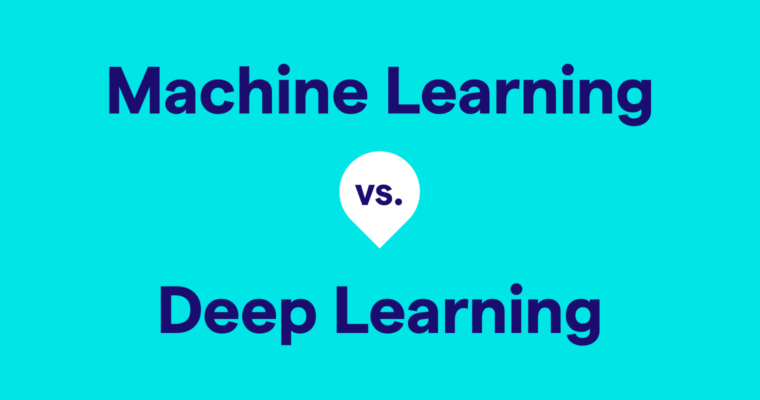
While machine learning and deep learning are often used interchangeably, they refer to two sub-domains of artificial intelligence. They represent different (but related) approaches to data analysis; deep learning is a subset of machine learning. The distinctions between them are important and become especially relevant when communicating on technical topics—such as when evaluating data analysis tools and services, deciding which approaches to take to solving a data problem, or having deep conversations with engineers and domain experts.
Table of contents
Machine learning vs deep learning
Applications of ML and deep learning
Benefits of ML and deep learning
Challenges of ML and deep learning
What is machine learning?
Machine learning (ML) is a subset of artificial intelligence (AI). The name refers to all systems where a machine (usually a computer or combination of computers) applies automatic mathematical and statistical techniques to discover or learn patterns from data.
ML aims to build systems that are intelligent and independent. That means it will learn patterns and improve on them from data, aiming to have few hard-coded components and reduced human interaction. The field of machine learning has existed since the 1960s, and there is a large body of algorithms and techniques that have been developed and studied since then.
Types of Machine Learning
Many different types of systems qualify as ML. These are the most common:
- Unsupervised learning models use unstructured data with little or no human guidance.
- Supervised learning models require guidance and depend on human input—including, for example, input on data format and structure.
- Semi-supervised models receive guidance from a small amount of structured data, then use insights from that data to refine their accuracy on a larger pool of unstructured data.
- Reinforcement models learn to make decisions by interacting with their environment. These models take actions, receive positive or negative feedback, then adjust behavior to achieve the desired goal.
- Self-supervised models create their own labels using raw, unstructured data.
What is deep learning?
Recent advances in ML have come primarily from a specialized subset of ML known as deep learning. Deep learning refers to the subset of ML systems that are implemented on top of a subset of neural networks that are called deep neural networks. Deep neural networks are neural networks that are large, heavily interconnected, and have many layers of neurons available for processing.
Types of deep learning networks
Like other advanced ML techniques, deep learning systems can learn in supervised or unsupervised ways. They can be built with just one or a combination of two or more advanced neural network architectures. Some networks, such as feed-forward neural networks (FNNs), only move data in one direction between neuron layers. In contrast, others, such as recurrent neural networks (RNNs), might form internal loops and, as a side effect, behave as if they have memory.
Advanced architectures such as convolutional neural networks (CNNs) structure how and when parts of the data are repeated in an NN’s input. This gives hints about where in the data the network should look for relationships.
Multiple neural networks can be developed in tandem, with each sub-network specializing in a subset of the problem space. For example, generative adversarial networks (GANs) tend to train models that try to compete with each other (one faking new data that should belong in a data set, and the other training to detect frauds), and two-tower architectures collaborate to learn about two deeply interconnected, but distinct, parts of a dataset.
More complex combinations of architectures are also commonly used together when building deep learning systems. These architectures can be extended using specialized neuron structures, such as transformers and rectifier units, or employed to emulate, implement, and enhance other machine learning systems, such as decision trees.
Machine learning vs. deep learning: key differences
Deep learning is a subset of machine learning and has some specific constraints and advantages built into it. Machine learning is a general term and covers a broader range of options and trade-offs for analyzing data and detecting patterns within it. This table highlights the differences. You’ll find more details below.
| Machine learning (ML) | Deep learning (DL) | |
| Flexibility | General; a subset of AI that encompasses various techniques to learn from data, with many options for implementation. | Implemented exclusively with neural networks; a specialized subset of ML focusing on deep, many-layered neural networks, and techniques that are well suited for them. |
| Human involvement | Covers the full range of algorithms, from those that work with structured data and require significant human pre-processing, to those that can operate fully independently. | Typically applied to extremely large data sets. Models work mostly with unstructured data and have a lower dependence on human processing and curation. |
| Scope | Broader scope, including traditional algorithms like linear regression, decision trees, and clustering. | Narrower focus within ML, specialized in handling large-scale data and complex tasks. |
| Technology basics | Employs a variety of algorithms such as decision trees, support vector machines, and ensemble methods. | Utilizes deep neural networks with many layers and techniques specifically meant to work with neural networks, like reinforcement learning and backpropagation. |
| Application areas | Any and all application areas where algorithms and computers can be used to automatically detect patterns in data. | Specialized for tasks that depend on complex pattern recognition from high volumes of unstructured data, such as general purpose text and image analysis, real-world problem-solving, and generative tasks. |
| Interpretability | Can be built in ways which are easy for humans to understand and interpret. Have been studied for much longer and have well-known properties. | Typically very accurate, while taking actions that are a lot harder for humans to follow and explain. |
| Examples | Spam detection, recommendation systems, customer segmentation. | Self-driving cars, virtual assistants (e.g., Siri), facial recognition systems. |
Deep learning depends on large data sets
Deep learning techniques often depend on having access to extremely large data sets, while ML systems can be useful when little to no data is available. Also, if skilled and specialized human input is available, ML can take advantage of it more explicitly than any deep learning system.
In general, ML systems cover a broader range of techniques and feature a more flexible range of implementation. Deep learning focuses exclusively on techniques suitable for working with large data sets, such as deep neural networks and their supporting algorithms.
ML can be easier to optimize and understand
With its much broader scope, ML covers many traditional and well-studied approaches to data processing, such as decision trees, clustering, and many flavors of regression. With decades devoted to their study, many of these approaches have well-known built-in performance and other trade-offs.
They offer more flexible implementations than neural-network-dependent deep learning systems and can be more resource- and cost-efficient. Deep learning is usually resource-heavy and sits at the high end of the cost scale.
Deep learning is more powerful and not as general
Deep learning systems are best for applications with a narrower scope and focus, for example, problems with large data troves of available related data, enough time for the lengthy training of a neural network, and when accuracy of execution is prioritized over the ability to trace exactly what the system is doing and why.
ML systems can be applied to the full range of problems where machines can automatically find and apply patterns in data, including ones where less data is available, where the systems are easy for humans to understand, and where high accuracy is less relevant.
Applications of ML and deep learning
ML-based and deep learning systems and applications are continuously embedded into more and more aspects of our lives. Here are some well-known examples below.
Spam detection
One of the earliest large-scale machine learning applications was to detect and filter spam email messages. The problem is an ideal one for applied machine learning.
There are large volumes of emails, and they have a well-defined structure. It’s easy to mark unwanted emails as spam, so it’s not difficult to create large data sets of emails marked as “spam” or “ham” (ham is the opposite of spam). Classification systems can be easily built on top of this data and then used to filter out spam emails at internet-scale quickly.
Spam detection is one example in which deep learning systems are not (yet) as well suited to solve as are more traditional ML techniques. Despite significant improvements, the time and cost required to keep deep learning systems up to date with the latest advancements in spam is not yet worth their higher accuracy. Deep learning systems can be used to optimize ML pipelines in general, and large-scale spam detection ML training systems may integrate them for that purpose.
Recommendation systems
E-commerce stores, media streaming services, and online marketplaces are just some of the examples of services that depend on being able to make recommendations about where users should spend their money. Recommendation systems are another typical example of a problem well suited to machine learning.
As users consume media and buy online, the underlying systems can build up large data sets with clear signals (the user consumed vs. the user didn’t consume). Both deep learning and more traditional ML techniques can be applied to this problem; large-scale recommender systems use clever combinations of both algorithm types.
Path-finding and self-driving cars
Traditional unsupervised ML algorithms built on well-known route-finding techniques, such as Dijkstra’s algorithm and the A* algorithm, are best suited for finding the best path between two points on a road map. These algorithms can study maps, traffic, and other data in advance, discover patterns, adjust in real-time based on real-world conditions, and work quite well.
When it comes to actually navigating a car between two points, though, the amount and complexity of information to be processed is much too high for any traditional ML technique to work with. Self-driving systems are almost exclusively built with deep-learning techniques.
Benefits of ML and deep learning
When used well, machine learning and specialized deep learning systems are transformative. They can augment human experts, making their output faster, more impactful, less expensive, higher quality, or a mix of all of the above.
Improved speed, scale, and cost with ML
ML systems can replace some or all of an expert’s work and processes, reducing the time and attention needed to complete a task. As a result, their work can be applied at a much higher scale than before.
For example, a team of technicians who evaluate MRI scans for abnormalities might each be able to evaluate six scans an hour, or around 200 a week. If the same team were to instead focus on training a set of machine learning algorithms to do the most routine parts of their analysis, the algorithms could evaluate thousands of MRI scans a week, at a fraction of the cost.
Higher impact and quality with deep learning
When applied to problems deep learning systems are well suited toward, they can augment systems that incorporate ML and increase their overall quality and impact.
Continuing the example above, deep learning systems might be applied to conditions with a large enough volume of MRI scans. If the volume of scans is sufficient, and after enough time and resources are devoted to building up the deep learning systems, they will likely do a better job than the experts can at identifying the narrow set of abnormalities they have been trained to identify.
These systems can then be deployed at scale for maximum impact, processing individual MRI scans at negligible costs. MRI technicians’ and other experts’ analyses can augment the deep learning systems’ output for unusual or exceptional cases, achieving even higher combined quality.
Challenges of ML and deep learning
While many kinds of work can benefit tremendously from applied ML or deep learning, incorporating AI like these into a system can be hard. Here are some of the most common challenges and obstacles that come up.
The trade-off between cost and accuracy
Larger and more expensive computer systems can run more advanced ML and deep learning algorithms faster and at a larger scale. As a result, there is a trade-off between how much money is spent on the system and how effective it is in terms of hardware and hiring more talented experts to assemble it. Effectively utilizing limited resources in ML and deep learning systems requires considerable care.
A dependency on large data sets
ML, in general, and deep learning specifically, depend on having access to continuously updated large data sets during their training phase. The algorithms are only as good as the quality and volume of data they are trained on. Managing large data sets effectively is difficult, and it takes time and ingenuity to apply ML most effectively to a given data set.
The trade-off between accuracy and clarity
Deep learning systems can be trained to be extremely accurate, much more so than other ML systems built with equivalent parameters. The accuracy comes at a cost; the systems manipulate data at a scale and use advanced algorithms that are impossible for humans to understand in a practical timeframe.
More traditional ML algorithms have been studied for much longer, have better-defined characteristics, and can be induced to work in ways that are easy for humans to understand. Any ML and deep learning implementation must find the ideal trade-off between accuracy and clarity.
The trade-off between technical bias and variance
As ML systems increase in the complexity of algorithms, the resources dedicated to training, and the amount of data used for training, they can learn more and more about the properties of their training data. This phenomenon is called (technical) bias; extremely biased systems will be very accurate when they see data similar to what they were trained on.
High bias often comes at the expense of too low a variance—the system won’t react much to new data that is very different from what it saw in training. Ideal systems, which are both low bias and low variance, are difficult to build. Finding the correct balance between bias and variance for a specific application is easier for better studied and more established traditional ML algorithms. It can be difficult to achieve with the more complex deep learning algorithms.
Conclusion
Deep learning systems are a specialized subset of ML that leverage deep, multilayered neural networks to tackle complex problems with large data sets. While they offer superior accuracy and processing capabilities, they come with trade-offs, such as reduced interpretability, reliance on extensive data, and limited optimization flexibility.
In contrast, traditional ML methods are often more cost-effective, easier to deploy, and provide more transparent and predictable outcomes. They are also simpler to fine-tune for specific tasks. Both approaches have distinct strengths and weaknesses, and understanding their applications and limitations is crucial for effective implementation in real-world scenarios.






